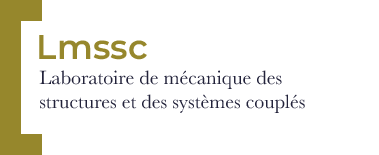Experimental and numerical analysis of the vibrational behavior of metallic structures filled with damping materials
Résumé
This work focuses on characterizing and modeling the vibrational behavior of hollow metallic structures filled with damping material. Vibration tests are first carried on a hollow structure, then two filling materials are considered: a cast viscoelastic material and a granular material composed of epoxy and polyurethane beads. Modal parameters (natural frequencies, modal damping and mode shapes) are extracted from the Frequency Response Functions with experimental modal analysis tools. Damping ratios greater than 5 % are measured. Given the difference in the nature of the filling materials, dissipation mechanisms are different. The effectiveness of a damping material depends on the type of structural modes (bending, torsion or wall mode) to be damped, and dissipation in filling materials cannot be modelled by a constant loss factor or viscous damping. Consequently, a finite element modeling of the structure filled with viscoelastic material is proposed. Numerical modal parameters of the structure are correlated with experimental measurements. By extension, a bead mix material law, based on a fractional Zener model, is proposed, whose parameters are obtained by inverse identification.

